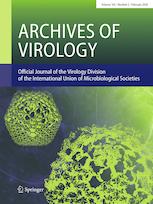Ver ítem
- xmlui.general.dspace_homeCentros e Institutos de InvestigaciónCICVyA. Centro de Investigación en Ciencias Veterinarias y AgronómicasInstituto de VirologíaArtículos científicosxmlui.ArtifactBrowser.ItemViewer.trail
- Inicio
- Centros e Institutos de Investigación
- CICVyA. Centro de Investigación en Ciencias Veterinarias y Agronómicas
- Instituto de Virología
- Artículos científicos
- Ver ítem
Equid herpesvirus type 3 infection produces membrane-associated and secreted forms of glycoprotein G that are not required for efficient cell-to-cell spread of the virus in vitro
Resumen
The ORF 70 gene of equid alphaherpesvirus type 3 (EHV-3) encodes glycoprotein G (gG), which is conserved in the majority of alphaherpesviruses. This glycoprotein is located in the viral envelope and has the characteristic of being secreted into the culture medium after proteolytic processing. It modulates the antiviral immune response of the host by interacting with chemokines. The aim of this study was to identify and characterize EHV-3 gG. By
[ver mas...]
The ORF 70 gene of equid alphaherpesvirus type 3 (EHV-3) encodes glycoprotein G (gG), which is conserved in the majority of alphaherpesviruses. This glycoprotein is located in the viral envelope and has the characteristic of being secreted into the culture medium after proteolytic processing. It modulates the antiviral immune response of the host by interacting with chemokines. The aim of this study was to identify and characterize EHV-3 gG. By constructing viruses with HA-tagged gG, it was possible to detect gG in lysates of infected cells, their supernatants, and purified virions. A 100-, 60-, and 17-kDa form of the protein were detected in viral particles, while a 60-kDa form was identified in supernatants of infected cells. The role of EHV-3 gG in the viral infection cycle was assessed by the construction of a gG-minus EHV-3 mutant and its gG-positive revertant. When growth characteristics in an equine dermal fibroblast cell line were compared, the plaque size and the growth kinetics of the gG-minus mutant were similar to those of the revertant virus, suggesting that EHV-3 gG does not play a role in direct cell-to-cell transmission or virus proliferation of EHV-3 in tissue culture. The identification and characterization of EHV-3 gG described here provide a solid background for further studies to assess whether this glycoprotein has a function in modulating the host immune response.
[Cerrar]

Autor
Losinno, Antonella;
Vissani, Maria Aldana;
Sanchez, Diego;
Damiani, Armando Mario;
Fuente
Archives of Virology 168 : article number: 122 (2023)
Fecha
2023-04
Editorial
Springer
ISSN
0304-8608
1432-8798
1432-8798
Formato
pdf
Tipo de documento
artículo
Palabras Claves
Derechos de acceso
Restringido
 Excepto donde se diga explicitamente, este item se publica bajo la siguiente descripción: Creative Commons Attribution-NonCommercial-ShareAlike 2.5 Unported (CC BY-NC-SA 2.5)
Excepto donde se diga explicitamente, este item se publica bajo la siguiente descripción: Creative Commons Attribution-NonCommercial-ShareAlike 2.5 Unported (CC BY-NC-SA 2.5)


